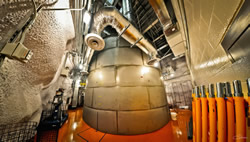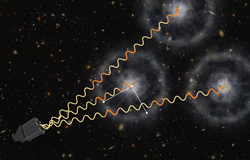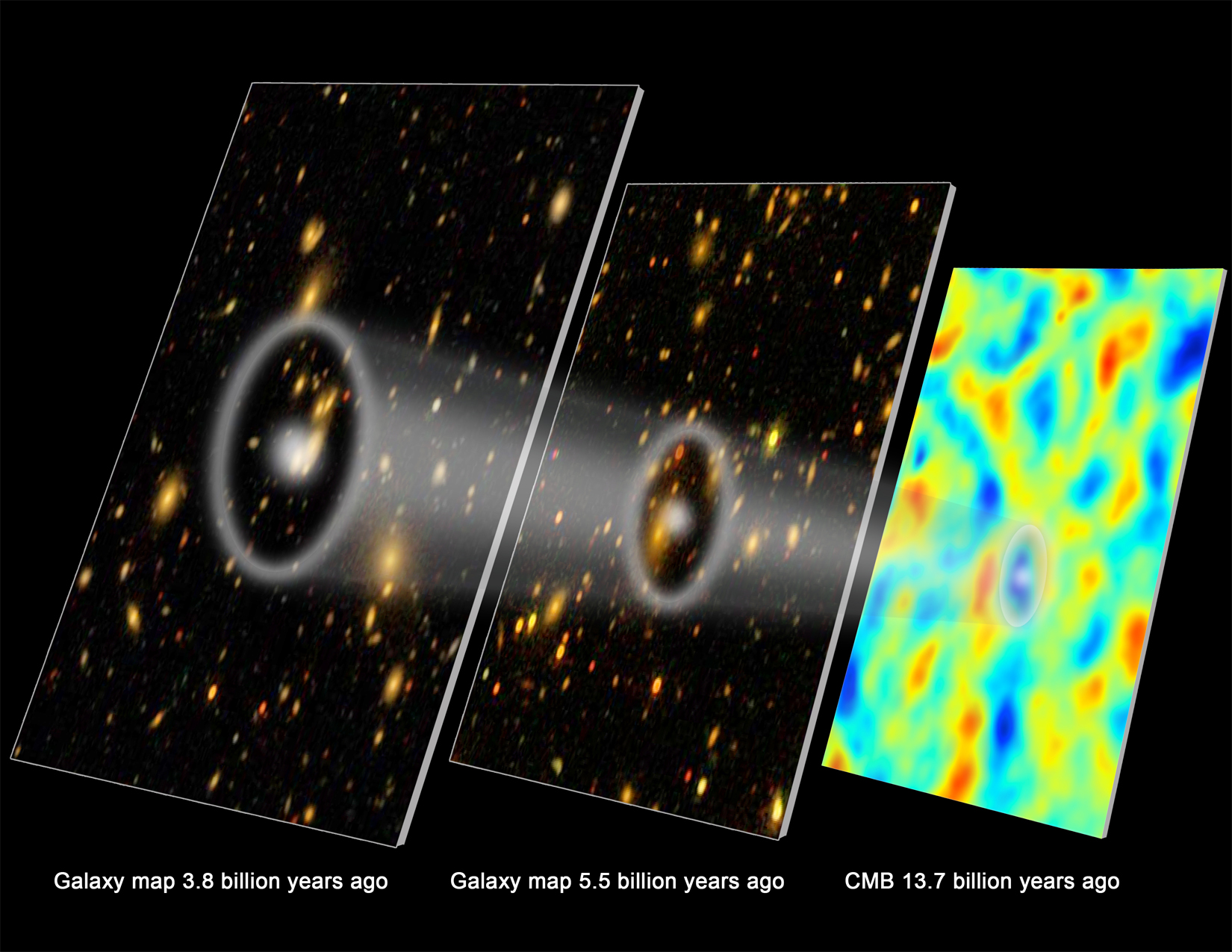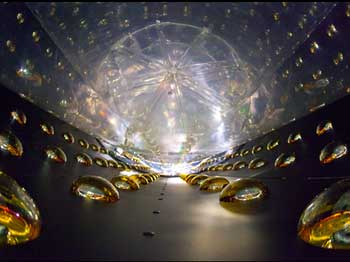The Press Room highlights computational astronomy work around the UC-HiPACC consortium; the wording of the short summaries on this page is based on wording in the individual releases or on the summaries on the press release page of the original source. Press releases below appear in reverse chronological order (most recent first); they can also be displayed by UC campus or DOE lab by clicking on the desired venue at the bottom of the left-hand column.
October 28, 2014 — Creating the coldest cubic meter in the Universe

An illustration of the cross-section of the cryostat with a human figure for scale. Credit: CUORE collaboration
October 2, 2014 — A closer look at the perfect fluid

A simulated collision of lead ions. Credit: ALICE experiment at CERN
October 1, 2014 — Hide & seek: Sterile neutrinos remain elusive
Photomultiplier tubes in the Daya Bay detectors. Credit: Roy Kaltschmidt/LBNL
July 15, 2014 — Next-generation dark matter experiments get the green light

The LZ water shield, currently housing the LUX experiment.
June 4, 2014 — Surprisingly strong magnetic fields challenge black holes’ pull

A computer simulation of gas (in yellow) falling into a black hole (too small to be seen). Twin jets are also shown with magnetic field lines. Image credit: Alexander Tchekhovskoy, LBNL
May 21, 2014 — Confirmed: Stellar behemoth self-destructs in a Type IIb supernova

A very hot, young supernova (arrow) marked the explosive death of a massive star in a galaxy known as UGC 9379 about 360 million light years away from Earth.
April 17, 2014 — Clocking the early universe’s expansion

As light travels to us from very distant quasars (white dots on the right), it passes through the expanding universe, carrying with it the story of its journey through this cosmic web. Astronomers have measured the expansion of the universe by tracing how quasar light has passed through these structures. (Illustration by Paul Hooper at Spirit Design with Mat Pieri and Gongbo Zhao, ICG; Courtesy: Third Sloan Digital Sky Survey)
April 7, 2014 — BOSS quasars track the expanding universe—the most precise measurement yet

An artist’s conception of how BOSS uses quasars to measure the distant universe. Light from distant quasars is partly absorbed by intervening gas, which is imprinted with a subtle ring-like pattern of known physical scale. Astronomers have now measured this scale with an accuracy of two percent, precisely measuring how fast the universe was expanding when it was just 3 billion years old. (Illustration by Zosia Rostomian, LBNL, and Andreu Font-Ribera, BOSS Lyman-alpha team, LBNL)
March 19, 2014 — Astrophysics team simulates key supernova phase at unprecedented resolution

The color map shows the magnitude of vorticity (the spinning motion of the fluid), with large regions of relatively strong turbulence shown in white/yellow. More at full iSGTW press release.
March 18, 2014 — Setting a trap for gravity waves

B-mode polarization of the cosmic microwave background radiation exhibits a distinctive 'curl,' either left or right-handed, imposed by the distortion of space as gravity waves moved through it. (Image BICEP2 Collaboration)
March 3, 2014 — Standard-candle supernovae are still standard, but why?

Type Ia supernovae result from the explosions of white dwarf stars. These supernovae vary widely in peak brightness, how long they stay bright, and how they fade away, as the lower graph shows. Theoretical models (dashed black lines) seek to account for the differences, for example why faint supernovae fade quickly and bright supernovae fade slowly. A new analysis by the Nearby Supernova Factory indicates that when peak brightnesses are accounted for, as shown in the upper graph, the late-time behaviors of faint and bright supernovae provide solid evidence that the white dwarfs that caused the explosions had different masses, even though the resulting blasts are all “standard candles.”
January 13, 2014 — Are Earths Rare? Perhaps Not

Artist’s representation of the “habitable zone,” the range of orbits where liquid water is permitted on the surface of a planet.
View full Lawrence Berkeley National Laboratory press release.
January 8, 2014 — BOSS Measures the Universe to One-Percent Accuracy

An artist's conception of the measurement scale of the universe. (Image: Zosia Rostomian, Lawrence Berkeley National Laboratory)
Read full Lawrence Berkeley National Laboratory press release.
December 16, 2013 — Supercomputers Capture Turbulence in the Solar Wind

Visualization zooms in on current sheets revealing the “cascade of turbulence” in the solar wind occurring down to electron scales. (Image: Burlen Loring, Berkeley Lab)
View full Lawrence Berkeley National Laboratory press release
November 21, 2013 — Searching for Cosmic Accelerators via IceCube

Detectors of the IceCube neutrino observatory are buried more than a mile below the South Pole
View full Lawrence Berkeley National Laboratory press release.
September 25, 2013 — Simulating the big bang and beyond
view full ISGTW Press Release
March 21, 2013 — Planck Mission Updates the Age of the Universe and What it Contains

The Planck mission has yielded the most detailed map yet of the cosmic microwave background radiation, from which crucial cosmological parameters have been recalculated.
view full LBNL Press Release
March 14, 2013 — Building the Massive Simulation Sets Essential to Planck Results

From left, Reijo Keskitalo, Aaron Collier, Julian Borrill, and Ted Kisner of the Computational Cosmology Center with some of the many thousands of simulations for Planck Full Focal Plane 6.
view full LBNL Press Release
February 20, 2013 — Searching for the Solar System’s Chemical Recipe

The protosun evolved in a hot nebula of infalling gas and dust that formed an accretion disk (green) of surrounding matter. Visible and ultraviolet light poured from the sun, irradiating abundant clouds of carbon monoxide, hydrogen sulfide, and other chemicals. Temperatures near the sun were hot enough to melt silicates and other minerals, forming the chondrules found in early meteoroids (dashed black circles). Beyond the “snowline” (dashed white curves), water, methane, and other compounds condensed to ice. Numerous chemical reactions contributed to the isotopic ratios seen in relics of the early solar system today.
view full LBNL Press Release
February 6, 2013 — The Last Big Bump Before a Supernova Explodes

The day the supernova exploded (a) it was surrounded by a shell of matter ejected a month earlier (purple) with a radius of 7,000,000,000 kilometers, moving 2,000 kilometers a second. An outer shell (orange) had been ejected earlier and was moving slower. By day 5 (b) the shock front (black circle) was moving 10,000 kilometers a second, and by day 20 (c) had engulfed the inner shell, exposing the debris of the exploded core. (Sketch adapted from Ofek et al, Palomar Transient Factory)
On August 25, 2010, the autonomous machine-learning framework (developed by Josh Bloom of Berkeley Lab’s Physics Division and Peter Nugent of the Computational Research Division and their colleagues) was combing through recent data from the Palomar Transient Factory (PTF) and came upon a Type IIn supernova, half a billion light years away in the constellation Hercules. Shortly thereafter, Eran Ofek of Israel’s Weizmann Institute of Science led a search of previous PTF scans of the stellar neighborhood and found its likely precursor, a massive variable star that only 40 days before it went supernova had shed a huge amount of mass.
view full LBNL Press Release
February 6, 2013 — A Massive Stellar Burst, Before the Supernova
view full NERSC Press Release
October 2, 2012 — Panofsky Prize Honors Researchers' Underground Hunt for Dark Matter

Blas Cabrera, the Stanley G. Wojcicki Professor in the Stanford Physics Department, who has a term appointment at SLAC, is a recipient of the 2013 W.K.H. Panofsky Prize in Experimental Particle... (Photo courtesy Stanford University)
The search for dark matter runs deep with physicists Blas Cabrera and Bernard Sadoulet, who have chased this mystery far underground and will be recognized for their work as joint recipients of the 2013 W.K.H. Panofsky Prize in Experimental Particle Physics. The prize is named for SLAC's founding director, Wolfgang "Pief" Panofsky, and awarded by the American Physical Society.
While some researchers are scanning the heavens with powerful telescopes to detect dark matter or crashing particles together in an effort to create and study its exotic components, Sadoulet, of the University of California, Berkeley, and Lawrence Berkeley National Laboratory, and Cabrera, of Stanford University and SLAC National Accelerator Laboratory, have sought the same answers in deep shafts largely shielded from cosmic rays and other unwanted particle "noise."
Their continuing, decades-long Cryogenic Dark Matter Search has brought them to several underground sites in the hunt for direct evidence of theorized weakly interacting massive particles, or WIMPs. If they are proven to exist, WIMPs could help define and explain dark matter, which is thought to make up about 25 percent of the energy density in the universe and is responsible for the formation of structure in the universe...
view full SLAC Press Release
September 24, 2012 — A Clock that Will Last Forever

Imagine a clock that will keep perfect time forever or a device that opens new dimensions into quantum phenomena such as emergence and entanglement.
Lynn Yarris (510) 486-5375 lcyarris@lbl.gov
Imagine a clock that will keep perfect time forever, even after the heat-death of the universe. This is the “wow” factor behind a device known as a “space-time crystal,” a four-dimensional crystal that has periodic structure in time as well as space. However, there are also practical and important scientific reasons for constructing a space-time crystal. With such a 4D crystal, scientists would have a new and more effective means by which to study how complex physical properties and behaviors emerge from the collective interactions of large numbers of individual particles, the so-called many-body problem of physics. A space-time crystal could also be used to study phenomena in the quantum world, such as entanglement, in which an action on one particle impacts another particle even if the two particles are separated by vast distances...
view full LBNL Press Release
September 17, 2012 — Berkeley Lab Sensors Enable First Light for the Dark Energy Camera

The Dark Energy Camera is mounted on the Victor Blanco 5-meter telescope at Cerro Tololo. Its focal plane consists of 62 large Berkeley Lab CCDs with exceptionally high sensitivity to the near infrared end of the spectrum. (Photos Roger Smith, NOAO, AURA, NSF; Blanco webcam; Fermilab; Roy Kaltschmidt, Lawrence Berkeley National Laboratory)
Paul Preuss 510-486-6249 paul_preuss@lbl.gov
Early in the morning of September 12 the Dark Energy Camera (DECam), mounted on the Victor Blanco Telescope at the Cerro Tololo Inter-American Observatory in Chile, recorded its first images of a southern sky spangled with galaxies. Galaxies up to eight billion light years away were captured on DECam’s focal plane, whose imager consists of 62 charge-coupled devices (CCDs) invented and developed by engineers and physicists at the U.S. Department of Energy’s Lawrence Berkeley National Laboratory (Berkeley Lab).
Berkeley Lab CCDs are noted for their exceptionally high sensitivity to light (quantum efficiency), particularly in the red and infrared regions of the spectrum – a crucial advantage for astronomical CCDs searching for objects at extremely high redshifts. Combining the 570-million-pixel focal plane made of Berkeley Lab CCDs with the light-gathering power of the Blanco telescope’s 4-meter mirror, DECam has unique ability to reach wide and deep into the night sky.
August 23, 2012 — Supernovae of the same brightness, cut from vastly different cosmic cloth

The supernova PTF 11kx can be seen as the blue dot on the galaxy. The image was taken when the supernova was near maximum brightness by the Faulkes Telescope North. The system is located approximately 600 million light years away in the constellation Lynx. Image Credit: BJ Fulton (Las Cumbres Observatory Global Telescope Network)
Exploding stars called Type 1a supernova are ideal for measuring cosmic distance because they are bright enough to spot across the Universe and have relatively the same luminosity everywhere. Although astronomers have many theories about the kinds of star systems involved in these explosions (or progenitor systems), no one has ever directly observed one—until now..."
view full LBL press Release
May 16, 2012 — Science Underground: Going to Great Depths

The tunnel on the left is the entrance to the cavern that will house the MAJORANA DEMONSTRATOR neutrino experiment and also provides access to the LUX experiment, which is searching for particles of dark matter. The tunnel to the right is a separate entrance to the cavern in which Ray Davis performed his famous neutrino experiment, now modified to house LUX. (Photo Matt Kapust)
The Davis Campus of the Sanford Underground Research Facility -- the Halls of Ivy it’s not.
The word “campus” brings to mind neo-Gothic bell towers and green lawns, not tunnels and caverns almost a mile underground. But that’s what the Davis Campus at the Sanford Underground Research Facility looks like, 4,850 feet down in the Homestake Mine in the Black Hills of South Dakota. Although SURF has weathered a series of funding ups and downs worthy of the rise and fall of the elevator cages that once took miners, and now scientists, to work in the mine, last year the U.S. Department of Energy successfully assumed sponsorship of the Sanford Lab’s scientific program from the National Science Foundation. DOE will maintain the mine as a home for existing and proposed projects to investigate dark matter, the secrets of the elusive neutrino, and other research that can only be done deep down in the dark...
view full LBL feature
April 18, 2012 — Where Do the Highest-Energy Cosmic Rays Come From? Probably Not from Gamma-Ray Bursts

IceCube’s 5,160 digital optical modules are suspended from 86 strings reaching a mile and a half below the surface at the South Pole. Each sphere contains a photomultiplier tube and electronics to capture the faint flashes of muons speeding through the ice, their direction and energy – and thus that of the neutrinos that created them – tracked by multiple detections. At lower left is the processed signal of an energetic muon moving upward through the array, created by a neutrino that traveled all the way through the Earth.
The IceCube neutrino telescope encompasses a cubic kilometer of clear Antarctic ice under the South Pole, a volume seeded with an array of 5,160 sensitive digital optical modules (DOMs) that precisely track the direction and energy of speeding muons, massive cousins of the electron that are created when neutrinos collide with atoms in the ice. The IceCube Collaboration recently announced the results of an exhaustive search for high-energy neutrinos that would likely be produced if the violent extragalactic explosions known as gamma-ray bursts (GRBs) are the source of ultra-high-energy cosmic rays.
“According to a leading model, we would have expected to see 8.4 events corresponding to GRB production of neutrinos in the IceCube data used for this search,” says Spencer Klein of the U.S. Department of Energy’s Lawrence Berkeley National Laboratory (Berkeley Lab), who is a long-time member of the IceCube Collaboration. “We didn’t see any, which indicates that GRBs are not the source of ultra-high-energy cosmic rays.”
view full LBNL Press Release
March 30, 2012 — Clocking an Accelerating Universe: First Results from BOSS

BOSS measures the three-dimensional clustering of galaxies at various redshifts, revealing their precise distance, the age of the universe at that redshift, and how fast the universe has expanded. The measurement uses a "standard ruler" based on the regular variations of the temperature of the cosmic microwave background (CMB), which reveal variations in the density of matter in the early universe that gave rise to the later clustering of galaxies and large-scale structure of the universe today. (Click on image for best resolution. Credit: Eric Huff, the SDSS-III team, and the South Pole Telescope team. Graphic by Zosia Rostomian)
Some six billion light years distant, almost halfway from now back to the big bang, the universe was undergoing an elemental change. Held back until then by the mutual gravitational attraction of all the matter it contained, the universe had been expanding ever more slowly. Then, as matter spread out and its density decreased, dark energy took over and expansion began to accelerate.
Today BOSS, the Baryon Oscillation Spectroscopic Survey, the largest component of the third Sloan Digital Sky Survey (SDSS-III), announced the most accurate measurement yet of the distance scale of the universe during the era when dark energy turned on.
“We’ve made precision measurements of the large-scale structure of the universe five to seven billion years ago – the best measure yet of the size of anything outside the Milky Way,” says David Schlegel of the Physics Division at the U.S. Department of Energy’s Lawrence Berkeley National Laboratory (Berkeley Lab), BOSS’s principal investigator. “We’re pushing out to the distances when dark energy turned on, where we can start to do experiments to find out what’s causing accelerating expansion.”...
view full LBNL Press Release
March 8, 2012 — New discovery is key to understanding neutrino transformations

The inside of a cylindrical antineutrino detector before being filled with clear liquid scintillator, which reveals antineutrino interactions by the very faint flashes of light they emit. Sensitive photomultiplier tubes line the detector walls, ready to amplify and record the telltale flashes. (Roy Kaltschmidt photo, LBNL)
BERKELEY - A new discovery provides a crucial key to understanding how neutrinos – ghostly particles with multiple personalities – change identity and may help shed light on why matter exists in the universe.
view UCB Press Release
view LBNL Press Release
January 11, 2012 — Calculating What’s in the Universe from the Biggest Color 3-D Map

This image shows over a million luminous galaxies at redshifts indicating times when the universe was between seven and eleven billion years old, from which the sample in the current studies was selected. (By David Kirkby of the University of California at Irvine and the SDSS collaboration.)
Since 2000, the three Sloan Digital Sky Surveys (SDSS I, II, III) have surveyed well over a quarter of the night sky and produced the biggest color map of the universe in three dimensions ever. Now scientists at the U.S. Department of Energy’s Lawrence Berkeley National Laboratory (Berkeley Lab) and their SDSS colleagues, working with DOE’s National Energy Research Scientific Computing Center (NERSC) based at Berkeley Lab, have used this visual information for the most accurate calculation yet of how matter clumps together – from a time when the universe was only half its present age until now...
December 14, 2011 — Closest Type Ia Supernova in Decades Solves a Cosmic Mystery

Before and after images of supernova PTF 11kly as it appeared in the nearby M101 galaxy. (Images: Peter Nugent)
Type Ia supernovae (SN Ia’s) are the extraordinarily bright and remarkably similar “standard candles” astronomers use to measure cosmic growth, a technique that in 1998 led to the discovery of dark energy – and 13 years later to a Nobel Prize, “for the discovery of the accelerating expansion of the universe.” The light from thousands of SN Ia’s has been studied, but until now their physics – how they detonate and what the star systems that produce them actually look like before they explode – has been educated guesswork.